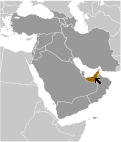World Atlas: United Arab Emirates. On this page you can see the map, country flag and many detailed information about the people, history and economy of United Arab Emirates.

Here you can find online selected information about the geography, inhabitants, government, economy and history of United Arab Emirates. Included are selected statistics, an overview map and the detailed map of United Arab Emirates. But let's start with the flag of United Arab Emirates here:
United Arab Emirates - Overview:
What you should know about United Arab Emirates? Let's start with this: The Trucial States of the Persian Gulf coast granted the UK control of their defense and foreign affairs in 19th century treaties. In 1971, six of these states - Abu Dhabi, 'Ajman, Al Fujayrah, Ash Shariqah, Dubayy, and Umm al Qaywayn - merged to form the United Arab Emirates (UAE). They were joined in 1972 by Ra's al Khaymah. The UAE's per capita GDP is on par with those of leading West European nations. For more than three decades, oil and global finance drove the UAE's economy. However, in 2008-09, the confluence of falling oil prices, collapsing real estate prices, and the international banking crisis hit the UAE especially hard. The UAE essentially avoided the "Arab Spring" unrest seen elsewhere in the Middle East in 2010-11 and in an effort to stem potential unrest, the government announced a multi-year, $1.6-billion infrastructure investment plan for the poorer northern emirates and aggressively pursued advocates of political reform. The UAE in recent years has played a vital role in regional affairs. In addition to donating billions of dollars in economic aid to help stabilize Egypt, the UAE is a member of a US-led global coalition to defeat the Islamic State in Iraq and the Levant (ISIL) and a coalition partner in a Saudi-led military campaign to restore the Government of Yemen.
Geography of United Arab Emirates
 Where on the globe is United Arab Emirates? The location of this country is Middle East, bordering the Gulf of Oman and the Persian Gulf, between Oman and Saudi Arabia. Total area of United Arab Emirates is 83,600 sq km, of which 83,600 sq km is land. So this is not a large country. How could we describe the terrain of the country? This way: flat, barren coastal plain merging into rolling sand dunes of vast desert; mountains in east. The lowest point of United Arab Emirates is Persian Gulf 0 m, the highest point Jabal Yibir 1,527 m. And the climate is desert; cooler in eastern mountains.
Where on the globe is United Arab Emirates? The location of this country is Middle East, bordering the Gulf of Oman and the Persian Gulf, between Oman and Saudi Arabia. Total area of United Arab Emirates is 83,600 sq km, of which 83,600 sq km is land. So this is not a large country. How could we describe the terrain of the country? This way: flat, barren coastal plain merging into rolling sand dunes of vast desert; mountains in east. The lowest point of United Arab Emirates is Persian Gulf 0 m, the highest point Jabal Yibir 1,527 m. And the climate is desert; cooler in eastern mountains.
Inhabitants of United Arab Emirates
Let's take a look how many people live in United Arab Emirates. The number is: 6,072,475 (July 2017 est.). So this is not very populous country. Who lives here? Emirati 11.6%, South Asian 59.4% (includes Indian 38.2%, Bangladeshi 9.5%, Pakistani 9.4%, other 2.3%), Egyptian 10.2%, Philippine 6.1%, other 12.8% (2015 est.). What are the languages in United Arab Emirates? Arabic (official), Persian, English, Hindi, Urdu. And the religions: Muslim (official) 76%, Christian 9%, other (primarily Hindu and Buddhist, less than 5% of the population consists of Parsi, Baha'i, Druze, Sikh, Ahmadi, Ismaili, Dawoodi Bohra Muslim, and Jewish) 15%. How old are the people in average? 30.3 years. We have to add that this number is the median - so one half of the people is older than this, one half is younger. And what is their life expectancy (at birth)? This: 77.7 years. Where the people live in United Arab Emirates? Here: population is heavily concentrated to the northeast on the Musandam Peninsula; the three largest emirates - Abu Dhabi, Dubai, and Sharjah - are home to nearly 85% of the population. The major urban areas of United Arab Emirates are: Dubai 2.415 million; Sharjah 1.279 million; ABU Dhabi (capital) 1.145 million (2015).
Government and Economy of United Arab Emirates
The capital of United Arab Emirates is Abu Dhabi and the government type federation of monarchies. Let's take a look at the administrative divisions - 7 emirates (imarat, singular - imarah); Abu Zaby (Abu Dhabi), 'Ajman, Al Fujayrah, Ash Shariqah (Sharjah), Dubayy (Dubai), Ra's al Khaymah, Umm al Qaywayn. Regarding the economy of United Arab Emirates, important industrial products are petroleum and petrochemicals; fishing, aluminum, cement, fertilizer, commercial ship repair, construction materials, handicrafts, textiles. Important agricultural products are dates, vegetables, watermelons; poultry, eggs, dairy products; fish. The most important export commodities are crude oil 45%, natural gas, reexports, dried fish, dates (2012 est.) and the most important export partners are India 9.9%, Iran 8.9%, Japan 8.8%, Switzerland 8.5%, Oman 5.4%, China 5.1% (2016). The most important import commodities are machinery and transport equipment, chemicals, food and the most important import partners are China 7.4%, US 6.9%, India 6.8%, Germany 4.4% (2016). How rich is United Arab Emirates and how rich are people in this country? The most important number here is GDP per capita (PPP): $68,200 (2017 est.). This means the people are rich on average here. Let's add that this means Gross Domestic Product per person, which is recalculated with respect to the relative cost of local goods and services. And one more important number - population below poverty line: 19.5% (2003 est.).